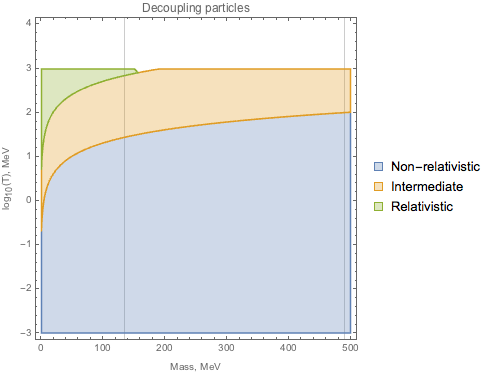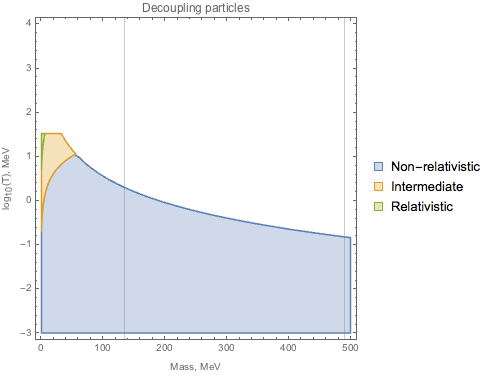Sterile neutrinos generation and decoupling
Decoupling temperature and regime
Heavy sterile neutrinos () are produced thermally at the temperatures (vaguely, depending on the mixing angle and the mass). Influence on the universe expansion at the later stages depends on the regime in which sterile neutrinos decouple from the plasma.
Decoupling happens when the interaction rate of the equilibrium-supporting reactions drops below the Hubble rate. In the radiation dominated epoch, Hubble rate can be conveniently approximated:
Typical interaction rate for 2-to-2 scattering () of the sterile neutrino with the coupling constant is of the form
where is the cross-section of the reaction , and is the relative velocity.
Coupling constant for sterile neutrinos is , so cross-section from dimensional considerations looks like
Kinematically considered reaction contains few parameters: invariant mass and scattering angles The total cross-section does not depend on the angle, so .
Then
This gives us corresponding decoupling temperatures for sterile neutrinos:
Hence, the distribution function of sterile neutrinos at the later times highly depends on the following factors:
- sterile-active mixing angle temperature dependence
- mass of the sterile neutrino
- regime of decoupling (relativistic/non-relativistic)
For example, if thermal corrections of are significant at the time of relativistic decoupling "in vacuum", sterile neutrinos might stay in the equilibrium longer and decouple being non-relativistic.
Using the analysis above, we assume no significant thermal corrections for the mixing angles and, for given mass and temperature, find the decoupling regime:
For
 For
For

The plotted regions correspond to non-equilibrium species in different regimes. In practice, as the temperature drops, when particle with given mass enters any of the regions - it decouples in the corresponding regime. For the sakes of certainty, the "intermediate" regime corresponds to the particle specie with .
Analysis of the decoupling regimes for the mass range of interest shows that for decoupling regime is rather relativistic, while for bigger values it is possible to get a fully-non-relativistic decoupling.
Decoupling and the QCD transition
Tuning of the parameters allows to shift the sterile neutrinos decoupling around the QCD transition temperature . The strong sector constituents of the plasma change enormously, requiring separate treatment of the quark-gluon and hadron phases and, possibly, the transition itself.
Decoupling above the QCD scale
At the temperatures above , plasma is full of quarks and gluons in equilibrium. Sterile neutrinos are singlets on SM gauge groups, so the only important interactions to consider are the weak interactions of quarks with active neutrinos. These processes are splitted into neutral and charged channels and due to the conservation of the lepton number, each 2-to-2 scattering diagram contains only 2 quarks. One has to take into account the number of degrees of freedom of quarks - in addition to the spin projections, each quark can carry one of 3 colors. Color is conserved in weak interactions, so each interaction amplitude is simply multiplied by .
As the first approximation, one can consider free quarks. The hadrons do not exist in the quark-gluon plasma, so their interactions with the sterile neutrinos are not taken into account.
where and denote the up or down component of the -th quark family.
Neutral channel reaction
where the momenta of particles denoted by the particle symbols:
For the upper quarks:
For the lower quarks:
The charge-conjugated channels expressions can be obtained by simply swapping , so the total interaction amplitudes are:
Charged channel reaction
where the momenta of particles denoted by the particle symbols:
Together with the charge-conjugated channel this gives: